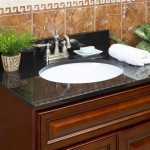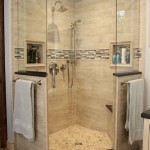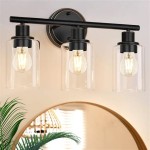The Enduring Appeal of Cross Handle Widespread Bathroom Faucets
The choice of bathroom fixtures often reflects a delicate balance between aesthetics, functionality, and practicality. Among the vast array of options available, the cross handle widespread bathroom faucet stands out as a classic design, offering a blend of traditional charm and reliable performance. This article explores the defining characteristics, advantages, installation considerations, and maintenance aspects of cross handle widespread bathroom faucets, examining their continuing relevance in contemporary bathroom design.
A widespread bathroom faucet, by definition, features separate handles for hot and cold water, mounted independently on the countertop or sink deck. These handles are connected to the faucet spout via supply lines concealed beneath the surface. This configuration offers flexibility in terms of installation and allows for a wider range of design options compared to center-set or single-hole faucets. The cross handle design introduces a distinctive visual element, characterized by handles shaped like a plus sign (+). This shape provides a comfortable grip and allows for easy water temperature and flow control.
The popularity of cross handle widespread bathroom faucets stems, in part, from their timeless design. They evoke a sense of classic elegance, reminiscent of traditional plumbing fixtures. While modern faucets often prioritize sleek, minimalist aesthetics, the cross handle faucet retains a sense of warmth and character. This quality makes it a versatile choice, complementing a variety of bathroom styles, from traditional and transitional to even some contemporary designs where a touch of vintage flair is desired.
The widespread configuration offers a practical advantage: it can accommodate sinks with three pre-drilled holes that are spaced further apart than those required for center-set faucets. This can be particularly useful during bathroom renovations where the existing sink cannot be easily replaced. Moreover, the separate handles allow for precise temperature control, as users can adjust the hot and cold water mix to their preference. The larger spacing between the handles and spout also provides ample space for handwashing and other bathroom activities.
Key Point 1: Design and Aesthetic Considerations
The cross handle widespread bathroom faucet's design is not merely aesthetic; it also contributes to its functionality. The cross shape provides a secure and comfortable grip, even when hands are wet or soapy. This ergonomic design minimizes the risk of slippage and ensures smooth and precise water flow adjustment. The handles themselves are typically crafted from durable materials such as brass, stainless steel, or zinc alloy, and are often finished with polished chrome, brushed nickel, oil-rubbed bronze, or other decorative coatings to match the overall bathroom décor. The variety of finishes available allows homeowners to customize the faucet to their specific style preferences.
Beyond the handles, the spout design also plays a crucial role in the overall aesthetic. Spouts can range from traditional gooseneck shapes to more contemporary, angular designs. The height and reach of the spout should be carefully considered to ensure adequate clearance for handwashing and to prevent splashing. Some widespread faucets also feature built-in aerators that mix air with the water stream, reducing water consumption without sacrificing water pressure.
The visible supply lines connecting the handles to the spout can also be considered a design element. While traditionally hidden beneath the countertop, some modern designs embrace the exposed plumbing aesthetic, using decorative supply lines made from polished brass or copper. This approach adds a touch of industrial chic to the bathroom and can be particularly effective in loft-style or minimalist bathrooms.
The widespread configuration allows for greater flexibility in terms of handle placement. The handles can be positioned closer together or further apart, depending on the size of the sink and the user's preferences. This adaptability makes the cross handle widespread faucet a suitable choice for a wide range of bathroom sizes and layouts.
Key Point 2: Installation Requirements and Procedures
Installing a cross handle widespread bathroom faucet requires some basic plumbing knowledge and skills. While a professional plumber can handle the installation quickly and efficiently, many homeowners with DIY experience can successfully install the faucet themselves, provided they follow the manufacturer's instructions carefully. The installation process typically involves the following steps:
First, the existing faucet must be removed. This involves turning off the water supply to the faucet and disconnecting the existing supply lines. A basin wrench can be helpful for loosening the nuts that secure the faucet to the sink. It is important to have a bucket and towels on hand to catch any residual water.
Next, the sink surface must be cleaned and prepared for the new faucet. Any old sealant or debris should be removed to ensure a proper seal. The mounting holes should be checked to ensure they are the correct size and spacing for the new faucet.
The faucet handles are then installed, typically by inserting them through the mounting holes and securing them with nuts and washers from underneath the sink. The supply lines are then connected to the handles and to the shut-off valves on the water supply lines. It is crucial to use plumber's tape or pipe dope on all threaded connections to prevent leaks.
The faucet spout is then installed, typically by connecting it to the handles via flexible supply lines. The spout is secured to the sink using a mounting plate and nuts. Again, plumber's tape or pipe dope should be used on all threaded connections.
Once all components are installed, the water supply should be turned on slowly, and all connections should be checked for leaks. If any leaks are detected, the connections should be tightened or re-sealed. It is also important to flush the faucet for a few minutes to remove any debris or sediment that may have entered the water lines during installation.
Specific installation instructions may vary depending on the manufacturer and model of the faucet. It is therefore essential to consult the manufacturer's instructions before beginning the installation process. If you are unsure about any aspect of the installation, it is best to seek professional assistance.
Key Point 3: Maintenance and Longevity
Like all plumbing fixtures, cross handle widespread bathroom faucets require regular maintenance to ensure optimal performance and longevity. The frequency of maintenance will depend on the water quality in your area and the usage of the faucet.
One of the most common maintenance tasks is cleaning the faucet to remove mineral deposits and soap scum. A mild soap and water solution is usually sufficient for routine cleaning. Avoid using abrasive cleaners or scouring pads, as these can scratch the finish. For stubborn mineral deposits, a mixture of white vinegar and water can be used to soak the affected areas. Rinse thoroughly after cleaning to remove any residue.
The faucet aerator should also be cleaned periodically to remove any debris that may be clogging it. The aerator can usually be unscrewed from the spout and rinsed under running water. If necessary, a small brush can be used to clean the aerator screen.
Over time, the faucet cartridges or valve stems may wear out, causing leaks or drips. These components can usually be replaced relatively easily. Replacement cartridges or valve stems are typically available from the manufacturer or from plumbing supply stores. It is important to identify the correct replacement part for your specific faucet model.
If the faucet handles become loose or difficult to turn, the handle screws may need to be tightened. These screws are usually located under decorative caps on the handles. Be careful not to overtighten the screws, as this can damage the handles or the valve stems.
In areas with hard water, it may be necessary to install a water softener to reduce the buildup of mineral deposits on the faucet and other plumbing fixtures. Water softeners can significantly extend the life of plumbing fixtures and reduce the need for frequent cleaning.
By following these simple maintenance tips, homeowners can ensure that their cross handle widespread bathroom faucet remains in good working order for many years to come. Regular maintenance will not only prolong the life of the faucet but also prevent costly repairs and water wastage.
In conclusion, the cross handle widespread bathroom faucet offers a combination of classic design, functional benefits, and relatively straightforward installation and maintenance. Its enduring appeal lies in its ability to blend seamlessly with a variety of bathroom styles while providing reliable performance and precise water control. By understanding the key characteristics and considerations outlined in this article, homeowners can make informed decisions about whether this type of faucet is the right choice for their bathroom.

West Slope Cross Handle Widespread Bathroom Faucet Rejuvenation

Cross Handle Widespread Bathroom Faucets The Home

Rers Widespread Lavatory Faucet 8 16 Inch Spread Metal Cross

West Slope Cross Handle Bathroom Faucet Rejuvenation

Waterhouse Cross Handle Widespread Bathroom Faucet Rejuvenation

Victorian 5 3 4 Double Metal Cross Handle Widespread Bathroom Sink Faucet With Pop Up Drain In Polished Nickel

Langford Cross Handle Widespread Bathroom Sink Faucet Pottery Barn

Two Handle Widespread Bathroom Faucet Low Arc Spout Less Handles 3595lf Mpu Lhp H295 Delta

Mercer Cross Handle Bathroom Sink Faucet Pottery Barn

K 14408 3 Cp Purist Widespread Bathroom Sink Faucet With Cross Handles 1 2 Gpm Studio Kohler
See Also







